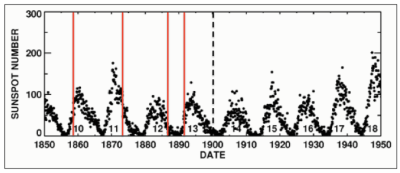Valderrama in the 21st Century
| Nugget | |
|---|---|
| Number: | 310 |
| 1st Author: | Hugh Hudson |
| 2nd Author: | |
| Published: | 31 October 2017 |
| Next Nugget: | Unusual Type III Burst Dynamics Produced by Diverging Magnetic Fields |
| Previous Nugget: | Electron Scattering in the Flaring Corona |
Introduction
The sudden spate of solar activity in September remarkably saw only the second GLE event of the current solar maximum, now almost past. This SOL2017-09-06 was then followed by a limb event, SOL2017-09-10, whose name rang a bell. On the same date just 131 years ago, as only the third documented solar flare, and the third of only five 19th-century white-light flares. The solar historical scholar José Vaquero, of the University of Extremadura, Spain, rediscovered this important observation via reference to the Comptes Rendus. This echo from the 19th century is relevant to RHESSI and our modern fleet of solar multi-messenger observatories.
The 19th Century
The list of 19th-century flare observations now comprises the following:
Carrington SOL1859-09-01 [2] Secchi SOL1872-11-13 [3] Valderrama SOL1886-09-10 [4] Trouvelot SOL1891-06-17 [5] Rudaux SOL1892-07-15 [6]
and one can note from Figure 1 that each of these events occurred actually in a different solar cycle, at quite different phases, up until Cycle 13. Thus they must have been exceptional phenomena in their contexts. Was the Carrington event different or more important, in the sense of being properly called a "superflare"? To say this, independent of the geomagnetic record, would require some sort of calibration of the perspicacity or diligence of these several independent naked-eye observers. Indeed, though Valderrama was only 17 years of age, and probably a sharp-sighted youth, he must have had minimal experience. Thus so for him to be so sure of his discovery, and to recognize what he was doing and to publish it in the Comptes Rendus, could imply that this event belongs in the same league as Carrington's.
The 21st Century
In the 21st century, to reclaim a phrase, solar multi-messenger astronomy is flourishing. From the list above we can note not only the 155th anniversary of the Carrington event, but also now the 131st anniversary of the Valderrama event, all within the scope of the RHESSI Science Nuggets. The actual SOL2017-09-10 was a spectacular limb event, and so its white-light continuum could not be detected, but probably it resembled SOL2017-09-09 as shown in Figure 2. This flare occurred in the remarkable solar active region NOAA12673, which went on to produce the solar cosmic-ray event GLE72, as described in the earlier Nugget. This later event was the Valderrama anniversary event, and Figure 2 shows the earlier X-class flare in white light from stock HMI observations. Perhaps the later event was more powerful, but this event doubled the brightness of the Sun locally, as estimated from the HMI data.

Even though this event doubled the solar surface brightness, in its patchy ribbon-like emission regions, it can hardly be seen in the direct magnified image, much less the whole-Sun image. Observers such as Valderrama (or Carrington) had the advantage of seeing the Sun evolve in time, suddenly, but these images show how difficult it must have been even then.
Conclusions
We can still learn from the 19th century about the properties of solar flares [1], but nowadays we have RHESSI and other multi-messenger paths to study their physics, and the physics of the impacts that they have upon the Earth and our environment in space. These very concepts were almost inconceivable in the 19th century; to explain the Carrington event's geoeffectiveness required the invention of X-rays and the discovery of the ionosphere, both of which lay in the future.
References
[1] "Evidence of a White-Light Flare on 10 September 1886"
[2] "Description of a Singular Appearance seen in the Sun on September 1, 1859"
[3] Comptes Rendus Acad. Sci. Paris 75, 1581, 1872: "Sur les taches et le diamétre solaires"
[4] "Ombres observees sur une tache solaire"
[5] "Phenomene Lumineux Extraordinaire Observe sur le Soleil"
